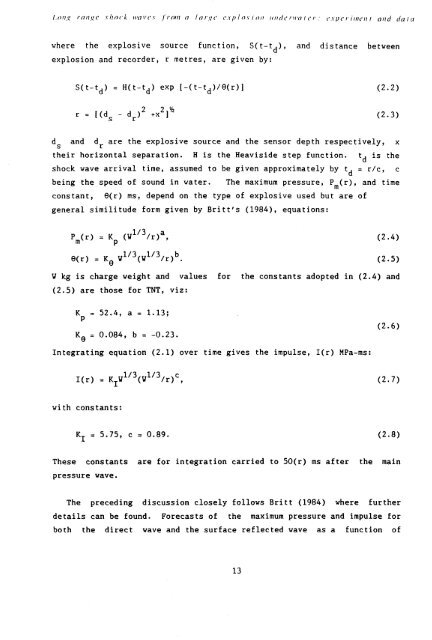Download (6Mb) - NERC Open Research Archive
Download (6Mb) - NERC Open Research Archive
Download (6Mb) - NERC Open Research Archive
Create successful ePaper yourself
Turn your PDF publications into a flip-book with our unique Google optimized e-Paper software.
,(/lIg rangc sImek II'(H'CS /1'0111 a large cxplosion IlIrdCI'II'Olcr: c.I'peril71(,1I1 alld dala<br />
where the explosive source function, S(t-t d ), and distance between<br />
explosion and recorder, r metres, are given by:<br />
(2.2)<br />
r = (2.3)<br />
d s and d r are the explosive source and the sensor depth respectively, x<br />
their horizontal separation. H is the Heaviside step function. td is the<br />
shock wave arrival time, assumed to be given approximately by td = ric, c<br />
being the speed of sound in water. The maximum pressure, P (r), and time<br />
m<br />
constant, e(r) ms, depend on the type of explosive used but are of<br />
general similitude form given by Britt's (1984), equations:<br />
P (r) = K (V 1/3 /r)a,<br />
m p<br />
(2.4)<br />
e(r) = Ke V1/3(V1/3/r)b. (2.5)<br />
v kg is charge weight and values for the constants adopted in (2.4) and<br />
(2.5) are those for TNT, viz:<br />
K 52.4, a = 1.13;<br />
p<br />
Ke 0.084, b = -0.23.<br />
Integrating equation (2.1) over time gives the impulse, I(r) MPa-ms:<br />
(2.6)<br />
I(r) (2.7)<br />
with constants:<br />
KI = 5.75, c 0.89. (2.8)<br />
These constants are for integration carried to 50(r) ms after the main<br />
pressure wave.<br />
The preceding discussion closely follows Britt (1984) where further<br />
details can be found. Forecasts of the maximum pressure and impulse for<br />
both the direct wave and the surface reflected wave as a function of<br />
13
















